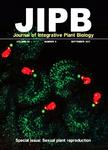Olive fruits infested with olive fly larvae respond with an ethylene burst and the emission of specific volatiles
Olive fruits infested with olive fly larvae respond with an ethylene burst and the emission of specific volatiles作者机构:CNR-Institute of Biosciences and Bioresources(IBBR)Perugia 06128Italy Department of Molecular EcologyMax Planck Institute of Chemical EcologyJena 07745Germany Department of AgronomyUniversity of Naples"Federico II"80055 PorticiItaly
出 版 物:《Journal of Integrative Plant Biology》 (植物学报(英文版))
年 卷 期:2016年第58卷第4期
页 面:413-425页
核心收录:
学科分类:0710[理学-生物学] 09[农学] 0904[农学-植物保护] 0901[农学-作物学] 0703[理学-化学] 090401[农学-植物病理学] 0902[农学-园艺学] 090402[农学-农业昆虫与害虫防治]
基 金:financially supported by the OLEA Project-Genomics and Breeding of Olive funded by MIPAF,Italy by the Max Plank Society
主 题:Bactrocera oleae biotic stress Olea europaea phytohormones plant defense volatile organic compounds
摘 要:Olive fly(Bactrocera oleae R.) is the most harmful insect pest of olive(Olea europaea L.) which strongly affects fruits and oil production. Despite the expanding economic importance of olive cultivation, up to now, only limited information on plant responses to B. oleae is available. Here,we demonstrate that olive fruits respond to B. oleae attack by producing changes in an array of different defensive compounds including phytohormones, volatile organic compounds(VOCs), and defense proteins. Bactrocera oleaeinfested fruits induced a strong ethylene burst and transcript levels of several putative ethylene-responsive transcription factors became significantly upregulated. Moreover, infested fruits induced significant changes in the levels of 12-oxophytodienoic acid and C12 derivatives of the hydroperoxide lyase. The emission of VOCs was also changed quantitatively and qualitatively in insect-damaged fruits, indicating that *** larval feeding can specifically affect the volatile blend offruits. Finally, we show that larval infestation maintained high levels of trypsin protease inhibitors in ripe fruits, probably by affecting post-transcriptional mechanisms. Our results provide novel and important information to understand the response of the olive fruit to B. oleae attack; information that can shed light onto potential new strategies to combat this pest.



